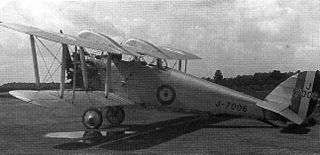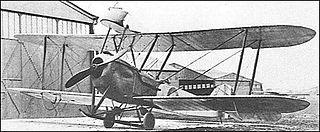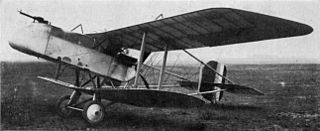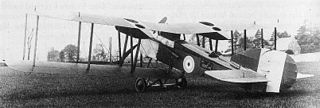Related Research Articles

Between 1911 and 1914, the Royal Aircraft Factory used the F.E.2 designation for three quite different aircraft that shared only a common "Farman" pusher biplane layout.

The Vickers F.B.5 was a British two-seat pusher military biplane of the First World War. Armed with a single .303 in (7.7 mm) Lewis gun operated by the observer in the front of the nacelle, it was the first aircraft purpose-built for air-to-air combat to see service, making it the world's first operational fighter aircraft.

The Vickers Virginia was a biplane heavy bomber of the British Royal Air Force, developed from the Vickers Vimy.

The Avro 549 Aldershot was a British single-engined heavy bomber aircraft built by Avro.

The Short Bomber was a British two-seat long-range reconnaissance, bombing and torpedo-carrying aircraft designed by Short Brothers as a land-based development of the very successful Short Type 184.
The Grahame-White Ganymede was a prototype British heavy night bomber intended to serve with the Royal Air Force in the First World War. A large, three-engined, twin-boom biplane, the sole prototype Ganymede did not fly until after the war had ended, and although an attempt was made to convert the aircraft to an airliner, it was unsuccessful.

The de Havilland DH.42 Dormouse and its two variants the de Havilland DH.42A Dingo I and II were two-seat single-engined biplanes designed for fighter-reconnaissance and army cooperation roles. They did not achieve production.
The de Havilland DH.72 was a large British three-engined biplane bomber, designed as a Vickers Virginia replacement. It did not go into production.
The Sopwith 2FR.2 Bulldog was a prototype British two-seat fighter of the First World War. A single-engined biplane, the Bulldog was a fighter/reconnaissance aircraft intended to replace the Bristol F.2 Fighter, but was unsuccessful, with no replacement for the Bristol Fighter being purchased.

The Vickers F.B.11 was a prototype British three-seat escort fighter of the First World War. A large single-engined biplane, it carried one gunner in a nacelle mounted on the upper wing to give an allround field of fire. Only a single example was completed.

The Vickers E.F.B.7 was a prototype British fighter aircraft of the First World War. A twin-engined biplane, the E.F.B.7 was unsuccessful, only a single example being built.

The Royal Aircraft Factory F.E.9 was a prototype British two-seat fighter-reconnaissance aircraft of the First World War. A single-engined pusher biplane of 1917, the F.E.9 had poor performance and handling, and only three were built.

The Royal Aircraft Factory N.E.1 was a prototype British Night fighter of the First World War. A single-engined pusher biplane, it was a development of the Royal Aircraft Factory's earlier F.E.9 fighter, but was not successful, only six being built.

The Westland Westbury was a British twin-engined fighter prototype of 1926. Designed by Westland Aircraft it never entered service but played a useful role in the testing of the COW 37 mm gun. Only the two prototypes were completed.
The Vickers F.B.24 was a British two-seat fighter aircraft of the First World War. Only a few prototypes were built, as, although it had good performance, the Bristol F.2 Fighter was preferred.

The Robey-Peters Gun-Carrier was a British three-seater armed tractor biplane designed and built by Robey & Company Limited at Bracebridge Heath, Lincoln for the Royal Naval Air Service (RNAS).

The Mann & Grimmer M.1 was a British prototype two-seat fighter aircraft of the First World War. It was a single-engined biplane with a radial engine in the aircraft's nose driving two pusher propellers, which was hoped to give a good field of fire for the gunner and high performance. Only one example was built, with no production following.
The Dyott Bomber was a prototype twin-engined British biplane bomber aircraft of the First World War. Two examples were built but the type was not adopted for service.
The Caproni Ca.61 was an Italian heavy day bomber aircraft of 1922. It was the final development of the Caproni three engine, twin boom biplane types developed during World War I, but it was not put into production.
The Astra 1916 bomber was a large 3-engined biplane, with two fuselages and a central nacelle. Power was supplied by three 220 hp (160 kW) Renault 12Eb water-cooled V-12 piston engines, two tractor engines in the noses of the fuselages and a pusher engine at the rear of the central nacelle. The flight crew of two sat in individual cockpits in the central nacelle and a gunner were housed in a cockpit, aft of the wings, in each fuselage. Designed for a 1916 concours puissant the performance of the aircraft was unsatisfactory and further development was abandoned.
References
Notes
Bibliography
- Bruce, J.M (1957), British Aeroplanes 1914-18, London: Putnam
- Bruce, J.M. (September 1959), "The F.E.4", Air Pictorial, Aircraft of the 1914-18 War, 21 (9), p. 335
- Mason, Francis K (1992), The British Fighter since 1912, Annapolis, Maryland, USA: Naval Institute Press, ISBN 1-55750-082-7